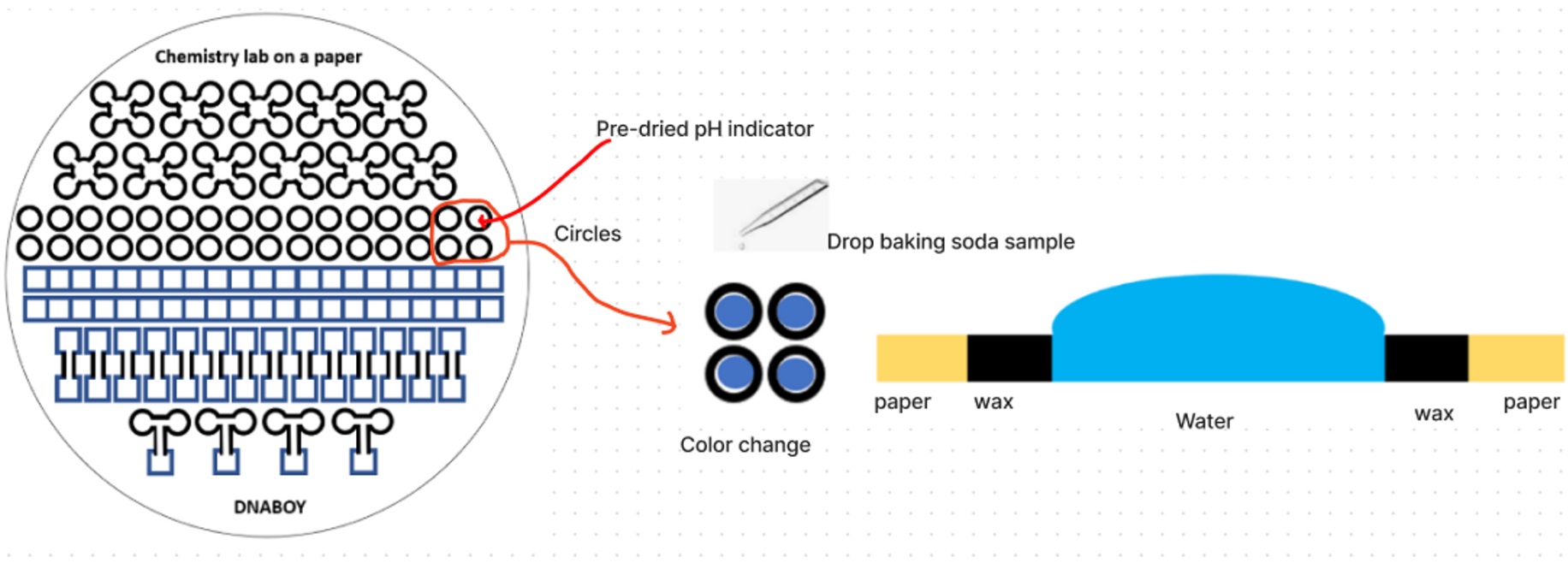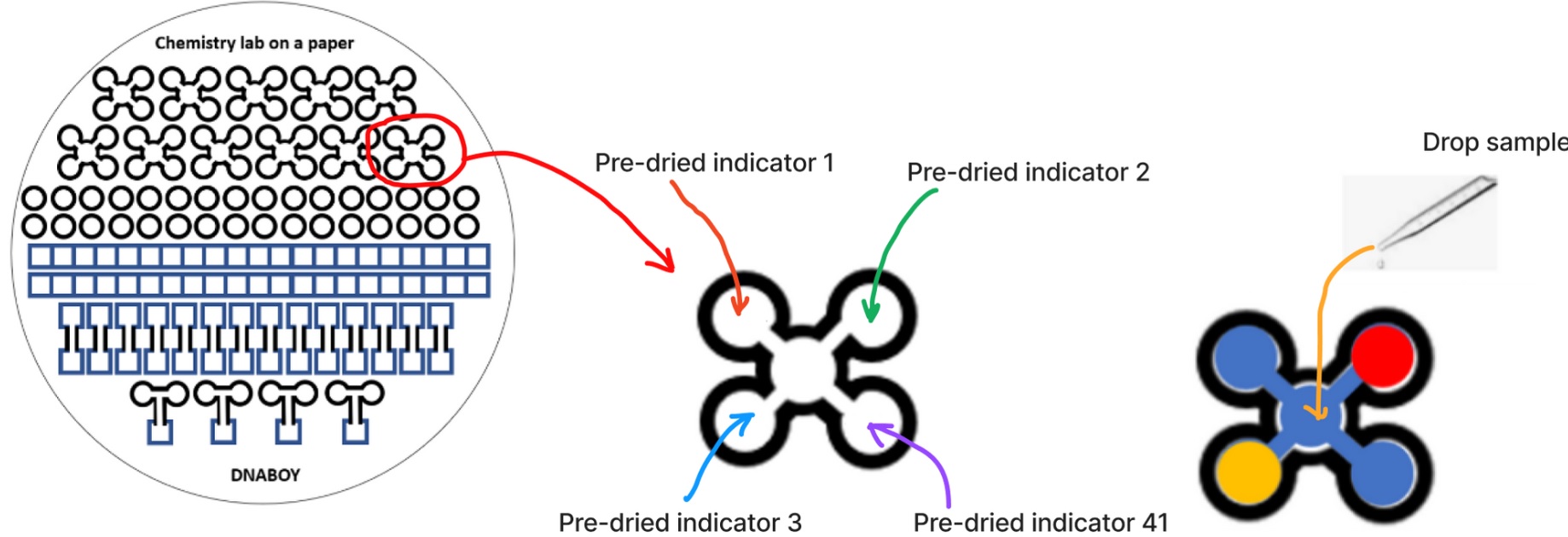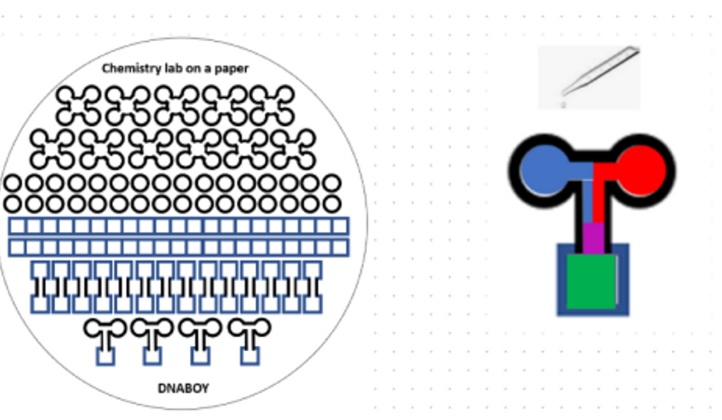Wax patterned paper
A paper analytical device (PAD) is a low-cost, portable, and easy-to-use platform for several analytical tests in clinical diagnostics, environmental pollution monitoring, and food and drug safety screening
Colorimetry lesson using ‘Lab-on-a-paper’
To carry out the experiment, you will need to prepare 2x2 circles from a PAD paper. The PAD paper is a low-cost diagnostic device that is portable, disposable and environmentally friendly. Using a pair of scissors, cut out the circles from the PAD paper. Next, using a pH indicator pen, deposit pH indicator on the inside of each circle. The pen contains a pH indicator dye named thymol blue that changes color to blue in a base and to red in an acid. Once the pH indicator has been deposited on the PAD paper, you can proceed with the experiment. Place a drop of liquid sample, such as vinegar or baking soda, on each circle. The wax pattern on the PAD paper confines the liquid sample inside the circle by the hydrophobicity of the wax. This ensures that the liquid sample does not spread outside the circle and does not mix with any other samples. After the liquid sample has been placed on the PAD paper, you will observe that the liquid sample will spread to the cellulosic paper by the hydrophilicity of the paper. The pH indicator dye will start to react with the liquid sample immediately after it is applied. The color change that occurs will depend on the pH of the liquid sample. If the liquid sample is acidic, the pH indicator dye will turn red. On the other hand, if the liquid sample is basic, the pH indicator dye will turn blue. This experiment is a simple and effective way to test the pH of a liquid sample using a PAD paper and a pH indicator pen. It is ideal for use in the classroom or at home and can be used to teach students about the basics of pH and how to test it using a simple and low-cost method. By performing this experiment, students can gain a deeper understanding of the scientific method and how it is applied in real-world scenarios.
Sample filtering
Sample filtering using capillary flow along cellulosic paper is a cost-effective and efficient method for filtering impurities from samples. To perform this method, a dumbbell-shaped pattern is cut out, with the pH indicator pre-deposited at one end of the dumbbell. A drop of baking soda sample is then placed at the other end of the dumbbell. As the water sample flows along the narrow channel, the dense cellulosic channel filters out any powdery impurities from the sample. The use of this method is particularly useful for pre-filtering impure samples such as soil or polluted water. The dumbbell-shaped pattern acts as a pre-filter, allowing for a more accurate and precise analysis of the sample. Additionally, the use of a pH indicator at one end of the dumbbell allows for easy detection of any color change that occurs when the liquid sample reaches the pH indicator region. Overall, sample filtering using capillary flow along cellulosic paper is a simple yet effective method for filtering impurities from samples. Its cost-effectiveness and ease of use make it a valuable tool for researchers, particularly those working with impure samples.
Multiple detection
The flower-shaped PAD is a powerful tool for the simultaneous detection of multiple analytes in a given sample. Each petal of the flower contains a pre-dried indicator for a different analyte. When the sample is applied to the center of the flower, it flows outwards to each petal, where it reacts with the pre-dried indicator. The color change in each petal indicates the presence or absence of the corresponding analyte. This allows for the detection of multiple analytes in a single test, making it a useful tool for environmental monitoring, clinical diagnosis, and food safety. The underlying principle of the flower-shaped PAD is the use of multiple pre-dried indicators, each sensitive to a different analyte. As the sample flows through the petals, it comes into contact with each of these indicators, causing a color change that can be easily observed. This color change is indicative of the presence or absence of the corresponding analyte in the sample. The flower-shaped PAD has many potential applications, particularly in environmental monitoring, where it can be used to detect multiple pollutants in water, air, and soil. It is also useful in clinical diagnosis, where it can be used to detect multiple pathogens in a single test. In food safety, it can be used to screen for multiple contaminants in food products, such as pesticides, heavy metals, and bacteria. One of the key advantages of the flower-shaped PAD is its simplicity and ease of use. The test can be performed without specialized equipment or trained personnel, making it accessible to a wide range of users. The pre-dried indicators are stable and have a long shelf life, making them ideal for use in resource-limited settings. In addition to its practical applications, the flower-shaped PAD also has important implications for research. It can be used to study the interactions between multiple analytes and their effects on biological systems. This can lead to a better understanding of complex biological processes and the development of new therapies and treatments. Overall, the flower-shaped PAD is a versatile and powerful tool for the simultaneous detection of multiple analytes in a single test. Its simplicity, ease of use, and potential for research make it an important tool for a wide range of applications, from environmental monitoring to clinical diagnosis to food safety.
Sample pretreatment
The Tee shaped PAD is a simple yet powerful tool that is widely used for sample pre-treatment in various fields such as environmental monitoring, clinical diagnosis, and food safety. The Tee shaped PAD is a type of paper analytical device (PAD) that is designed to prepare samples for analysis. It consists of a filter paper that is cut into a Tee shape, with the right wing reserved for the indicator reagent and the left wing reserved for the pre-treatment reagent. The stem area is for sample addition. One of the key advantages of the Tee shaped PAD is its cost-effectiveness. The materials required to prepare the Tee shaped PAD are inexpensive, and the device is easy to prepare and use. In addition, the Tee shaped PAD is highly portable, making it an ideal tool for field work. The Tee shaped PAD is particularly useful for pre-treatment of samples that require chemical modification before analysis. The pre-treatment reagent is used to modify the analyte, making it more amenable to detection by the indicator reagent. This allows for a more accurate and precise analysis of the sample, particularly when dealing with complex matrices. The pre-treatment step can also be used to remove interfering substances, which can improve the selectivity and sensitivity of the analysis. The Tee shaped PAD can be used for a wide range of analytes, including ions, small molecules, and biomolecules. The choice of indicator and pre-treatment reagent depends on the specific analyte of interest. The indicator reagent is chosen based on its ability to detect the analyte of interest, whereas the pre-treatment reagent is chosen based on its ability to modify the analyte in a way that enhances its detection. One of the key features of the Tee shaped PAD is the flow of the indicator and pre-treatment reagents. The reagents flow together and mix, and finally, they meet the sample. The color change that occurs is indicative of the presence or absence of the analyte in the sample. The flow of the reagents is driven by capillary action, which means that no external force is required. In conclusion, the Tee shaped PAD is a simple yet effective tool for sample pre-treatment. Its cost-effectiveness, portability, and ease of use make it a valuable tool for researchers. Its potential applications are numerous, including environmental monitoring, clinical diagnosis, and food safety. The Tee shaped PAD is a versatile tool that can be used to prepare a wide range of samples for analysis, and its use is expected to continue to grow in the future.
It's a wonderful education tool for chemistry teachers. Simple but efficient to teach students how colorimetry works

Middle school teacher
Pohang, Korea
'MylittleChemiLab' is a fantastic educational tool that is both simple to use and highly efficient in teaching the principles of colorimetric assay. This innovative kit, developed by DNABOY, contains a reagent dispensing pen, a wax-patterned paper, and an AI camera that can quickly and accurately digitize color changes. One of the standout features of the MylittleChemiLab kit is the reagent dispensing pen. This pen uses a pH indicator as ink, allowing kids to draw dots and lines that change color based on the pH level. This simple yet ingenious feature allows children to experiment with different pH levels and observe the corresponding color changes, making it an ideal tool for introducing the concept of pH to young learners. The wax-patterned paper included in the kit is another key component of the MylittleChemiLab experience. This paper is specially designed to interact with the pH indicator ink used in the reagent dispensing pen, making it easy for kids to create their own colorimetric assays. The paper is also durable and easy to handle, making it an ideal surface for conducting experiments. Finally, the AI camera included with the kit is a powerful tool for digitizing color changes. By capturing images of the wax-patterned paper, the camera can quickly analyze the color changes and provide instant feedback to the user. This feature is particularly useful for helping kids visualize the results of their experiments and gain a deeper understanding of colorimetric assay principles.
Project information
- Category Lab-on-a-paper
- Client SAGA Global Academy
- Project date May, 2023



